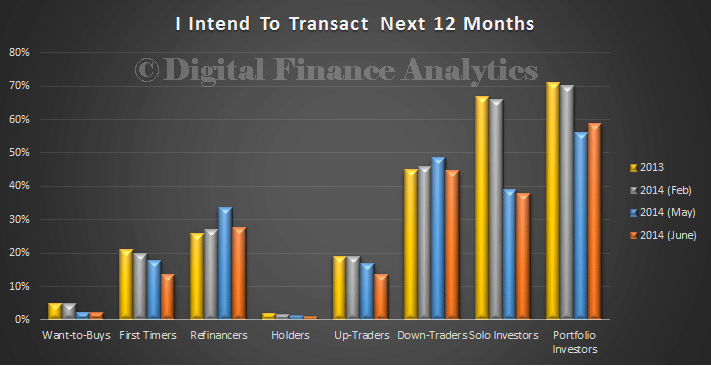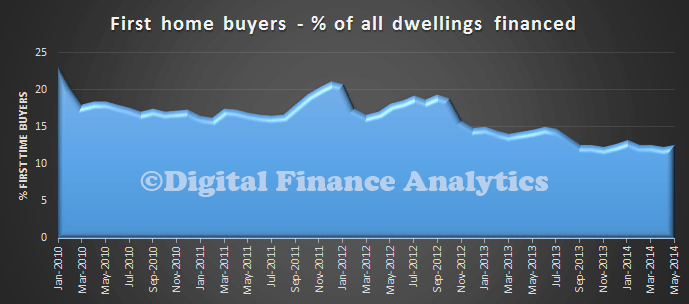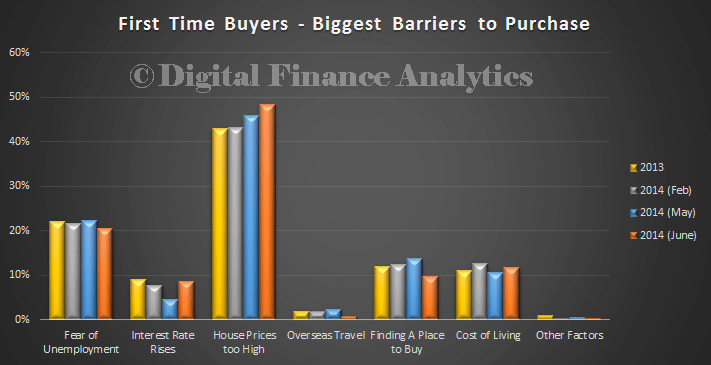Cross-posted from Martin North’s DFAblog.
Reflecting on the ABS data released today, and already covered here, and putting that into context of our household surveys, we think momentum is changing and the housing sector could stall in coming months. Demand for new finance fell 0.8% in May. Whilst refinancing remains quite buoyant, thanks to low rates, investors appear to be slowing, as already foreshadowed in our surveys.

First time buyers are still at low levels,

And they are still priced out of the market.

The current low interest rates and rising prices have together encouraged households to transact sooner than they might otherwise would, pulling transactions forwards, but this won’t last.
So, if future demand is not coming from first time buyers and investors, where will demand come from? Well, we know there are many households who would like to enter the market, but cannot because prices are too high, these property inactives won’t change their tune anytime soon. Will foreign investors keep the property ship afloat? The problem here is there is little good data on overseas investors, and in any case, is this sensible policy? The contribution which SMSF investors might make will hardly move the dial.
We also know that unemployment is up, and likely to continue to trend this way, which directly impacts households and mortgage stress. In addition consumer confidence is not that flash.
We think interest rates may be taken down by the RBA later in the year, but lower rates wont bring more households out of the woodwork because the banks won’t relax their serviceability buffers any further.
Putting all this together, it is likely we are at the top, and both house prices and lending will probably reverse later in the year. This creates a massive problem for the RBA who were banking on housing being the economic bridge between the end of the mining boom and the return to growth from other commercial sectors.
We should have implemented policies to stimulate the commercial sector earlier, rather than inflating house prices and the banks balance sheets with unproductive lending. Lending to business returns growth to the economy, flowing funds to inflated housing does not.
Editor’s update:
North also appears at the AFR today:
HomeFirst tells buyers they can raise a 5 per cent deposit with as little as $2500. The rest comes from a personal loan and a government first-home owners grant, which is worth $10,000 in Victoria. On a $400,000 property, that’s a debt gearing of 99.375 per cent.
“That’s doubling down,” said Fred Schebesta, co-founder of debt comparison website finder.com.au. “To take a personal loan to use as a deposit for a home loan – that’s pretty strong.”
Martin North, principal at Digital Finance Analytics, said warnings to banks by the Australian Prudential Regulation Authority have cut the proportion of high loan-to-value loans they sell. But smaller lenders are rushing in to fill demand. Finder.com.au lists at least five loans that require 5 per cent or lower deposits. Builders will also “find all sorts of ways to help bridge the gap between the cost and what people can afford”, Mr North said.
“The question is, are high loan-to-value loans more risky?” he said. “In a rising market, probably not, but if house prices were to start reversing and dropping, then these would be the ones that come under pressure first.”
…In Britain the Bank of England has imposed limits on mortgage lending to curb the prospect of a credit-driven housing boom.
Mr North said the same lending practices were emerging in Australia.
“You can understand the pressures to try and borrow more, but it is pressure that should be resisted because from a financial stability perspective, from a borrower perspective and from what it does to house prices, it’s a bad thing,” he said.

